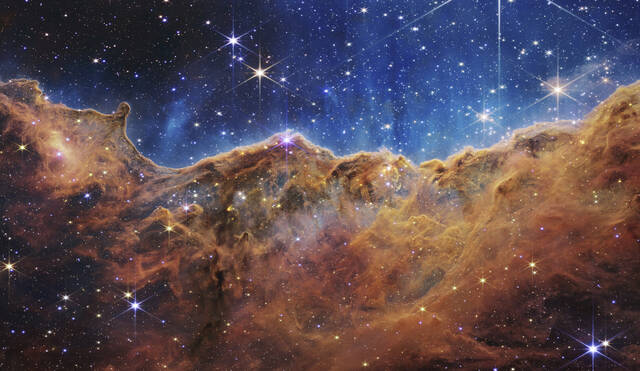https://development.triblive.com/local/regional/area-astronomers-space-enthusiasts-alike-rave-over-first-images-from-james-webb-space-telescope/
Astronomers, space enthusiasts rave over 1st images from James Webb Space Telescope

Imagine feeling like a kid on Christmas morning — for two days in a row.
For lifelong space enthusiast Bob Bickers of Murrysville, that’s what this week has been like as NASA releases the first images from the $10 billion James Webb Space Telescope.
“Stunning, just stunning. The images certainly didn’t disappoint,” said Bickers, 66, a retired attorney who has given talks on astronomy and displayed his 50-plus-year collection of space memorabilia and artwork at area libraries over the years.
“This is only a very tiny segment of the sky … a tiny, tiny, little spot. The images show giant galactic clusters out there, and it’s so far beyond the human experience we’ve ever seen … it’s hard to wrap your mind around it,” Bickers said after the release of the second round of photographs Tuesday morning.
The first full color picture from the telescope was released Monday.
More star news• Baby stars, dancing galzxies: NASA shows new cosmic views
The image was described by experts and novices alike as the deepest, most detailed infrared view of the universe to date and the farthest humanity has ever seen in time and distance.
Tom Reiland, director of the Nicholas E. Wagman Observatory at Deer Lakes Park, Allegheny County, anticipates a surge in public interest with release of the images.
“With these incredible cameras, it’s something quite special. There’s definitely a significant improvement in the resolution of these images and the detail,” Reiland said.
“People are always extremely interested in space and astronomy, as attendance at our public events often show. And public events like the release of these images only increase that interest,” Reiland said.
The first images from the world’s largest and most powerful space telescope demonstrate Webb at its full power and show it is ready to begin its mission to unfold the infrared universe, said Daniel Horenstein, manager of Buhl Planetarium & Observatory and astronomy expert at Carnegie Science Center in Pittsburgh.
“The ambition of the James Webb Space Telescope mission is striking,” Horenstein said.
“Infrared observations are notoriously difficult to collect on Earth because heat from the air around you can blur out your data. You can launch a telescope into space, where it is easier to keep the telescope cold, but space telescopes have to be small enough to fit inside a rocket, which limits the telescopes’ clarity. (The Webb telescope) bridges this gap,” he said.
“The images so far are phenomenal … mind-blowing, actually. And this is just the very start,” Horenstein said.
Daniel Vanden Berk, a researcher in space science and director of the Angelo J. Taiani Planetarium at Saint Vincent College’s Sis and Herman Dupré Science Pavilion in Unity, said the public and experts alike were thrilled by the images from the Hubble telescope released years ago, but this week’s images “are really stunning.”
“These are just spectacular views we’ve never seen before. These images are farther away and of higher resolution than we’ve ever seen,” he said.
“And the exciting part is that we’ve barely scratched the surface. We’re going to be utilizing this telescope for decades and decades in the future … who knows what information we’ll be able to gather down the road,” he said.
Horenstein concurred with Reiland’s assessment, particularly based on the questions he was getting from the public Monday and Tuesday at the planetarium. He conducted a question-and-answer session Tuesday afternoon from spectators at the science center, and the planetarium is planning to livestream Wednesday’s 3 p.m. scheduled briefing by NASA officials regarding the images.
“I certainly hope and expect interest to grow. It’s great to get people to talk about this universe around us,” Horenstein said.
Bickers maintained the images released Tuesday were equally as “amazing” as the first one.
“They showed the formation of dust storms from the formation of stars, a planet light years away from earth and galaxy clusters that exist farther than humans have ever seen before,” he said. “These are all sights we’re seeing for the first time.”
He can’t wait for the upcoming images.
“We’re going to learn so much more because of this,” he said. “That’s the exciting part, that this is just the start of it.”
Copyright ©2025— Trib Total Media, LLC (TribLIVE.com)
